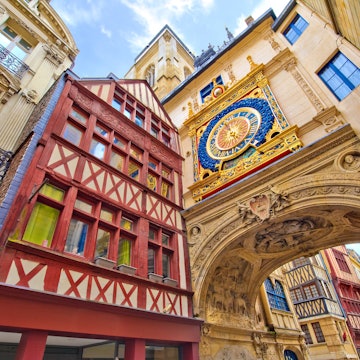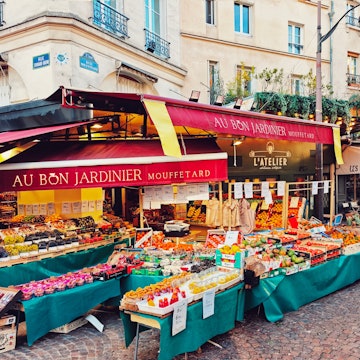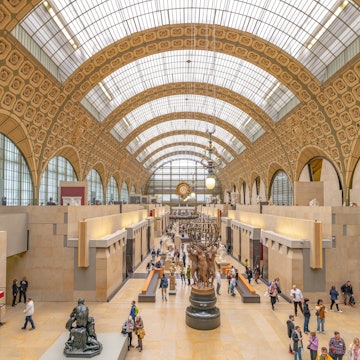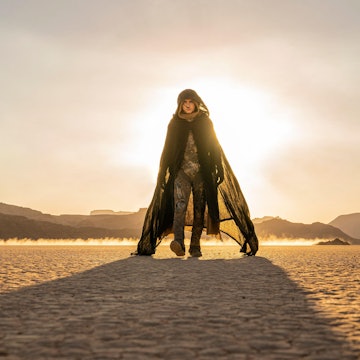

A double bassist belting out Jazz on the bank of the Seine, Paris. Christian Rummel / Getty Images
Jazz music has infused Paris since the Great War. Building on the genre’s rich, politically influential and often serendipitous history, an evocative jazz scene still resonates in the French capital today, thriving in fantastically atmospheric venues such as ancient stone cellars.
Clubs across the city stage exhilarating concerts and free-wheeling jam sessions that run deep into the night, while jazz is celebrated at festivals year-round and often in some magical open-air settings.
WWI beginnings: a new sound for Paris
Jazz sounded its first notes in Paris during WWI, when African-American soldiers, then stationed in France with the US army, came together to play ragtime and jazz in the city's music halls. Following the war, during les années folles (the 'crazy years' of the 1920s), jazz took hold as exuberant Parisians embraced the music, culture and philosophy that accompanied it. The capital of a country whose national motto remains liberté, égalité, fraternité (liberty, equality, brotherhood) was a magnet for US performers including Josephine Baker, Ella Fitzgerald and Louis Armstrong, who were facing racial segregation in their homeland.
Interwar birth of French jazz
Economic pressures from the Great Depression forced many US performers to return to America. In their absence, local musicians began experimenting with the style. Trailblazing guitarist Django Reinhardt, a Belgian-born French national of Manouche Romani descent, was at the forefront of the movement (despite a 1928 caravan fire leaving two fingers on his left fretting hand permanently paralysed when he was 18). In the 1930s, Reinhardt and Parisian violinist Stéphane Grappelli jammed in sessions promoted by the association Hot Club de France. They formed the Quintette du Hot Club de France, the first 'all-French' jazz band, recording together and opening for American jazz star Coleman Hawkins, cementing the arrival of Jazz Manouche aka Gypsy Jazz.

WWII and its legacy
When Paris fell under Nazi Occupation during WWII, audiences were drawn to the freedom jazz evoked. To avoid its suppression, the term 'jazz' was adopted as a catch-all for styles that encompassed swing, which the Nazis equated with defiance and punished with incarceration.
Rebellious locals successfully convinced the Nazis that jazz was a long-standing French tradition, and radio stations broadcast it alongside Nazi propaganda. Many songs were retitled during this time (for instance I Got Rhythm became Agate Rhythm or Blues in C Sharp, and St Louis Blues became Tristesse de St Louis), artists went under pseudonyms (Louis Armstrong used the name Jean Sablon), and jazz went underground, with clandestine clubs operating in soundproof cellars. Django Reinhardt’s Nuages became an anthem of the French Resistance, which used the clubs as a means to transmit messages; Resistance members included Hot Club's co-founder Jacques Bureau and entertainer Josephine Baker.
After the war, American musicians returned to play in Paris. Jazz legends at the inaugural Festival International de Jazz in Paris in 1948 included Dizzy Gillespie; in 1949, the bill featured fellow bebop progenitor Charlie Parker, along with Sidney Bechet, Thelonius Monk, Mary Lou Williams and Miles Davis. Throughout the 1950s and '60s, Paris was a focal point of the global jazz scene; clarinettist Claude Luter, who accompanied Sidney Bechet, had huge success with his Dixieland band during the era. Another wave of jazz clubs sprang up in the 1980s, with more opening their doors ever since.
Parisian jazz clubs today
It's possible to catch a live jazz performance on every night of the week in Paris. Fabled Left Bank venues include Caveau de la Huchette, in a Latin Quarter caveau (cellar). Dating from the 16th century and used as a courtroom and torture chamber during the French Revolution, it hosted a roll-call of jazz greats after opening in 1949.
Café Universel is a vibrant spot for free concerts by young local artists experimenting with bebop and vocals through to Latin sounds. Near the chestnut-shaded park Jardin du Luxembourg, Dixieland, big band and swing all feature at Le Petit Journal St-Michel. Chez Papa, in St-Germain, serves superb traditional French menus accompanied by piano duets, blues, sax solos and singers.
On the Right Bank, Les Halles has a trio of lauded jazz clubs footsteps apart on the same street: sophisticated Duc des Lombards, with up-close seating; earthy Le Baiser Salé (the 'Salty Kiss'), with diverse acts and electrifying jam sessions; and Sunset/Sunside, a double venue with eclectic sets at basement Sunset and ground-floor Sunside. Deep below ground in Le Marais, an exposed-stone cellar houses Cave du 38 Riv', which programs a wide range of styles, such as bossa nova or funk, and hosts spirited late-night jams.
Near Canal St-Martin, cherished 500-capacity venue New Morning has played host to Chet Baker and Dizzy Gillespie among others. Up in hilly Montmartre, Bab-Ilo is especially intimate, squeezing in just 40 people (give or take). Inside the 1972 hotel Le Méridien Étoile, on central Paris' western edge, Jazz Club Étoile is renowned for quality jazz (past performers include BB King and Lionel Hampton).

Jazz festivals
Top billing on Paris' jazz calendar goes to the Paris Jazz Festival: on weekends in the second half of June and throughout July, concerts strike up in the Parc Floral de Paris, within Paris' rambling eastern forest, the Bois de Vincennes, with a stage set in the lake. During the first half of September, Jazz à la Villette festival has sessions in the futuristic Parc de la Villette and its surrounding venues including the Philharmonie de Paris and Cabaret Sauvage.
In mid to late October, Jazz Sur Seine showcases some 400 musicians at low-priced concerts held at jazz clubs in Paris and the surrounding Île-de-France region. Headlining jazz, blues and R&B acts perform during the Banlieues Bleues (Suburban Blues) festival from mid-March to mid-April at venues in Paris’ northern suburbs.
Jazz musicians are among the performers playing on street corners and stages outside bars during the free Fête de la Musique on the summer solstice. And throughout the year, buskers provide more free jazz on Paris's streets, squares and the metro (a coveted gig for which they audition).
Need to know
Concerts and festivals are listed on the Paris Jazz Club website.
For unticketed jazz club performances, even 'free' admission generally incurs a surcharge of a few euros and requires you to purchase a drink (often you order and pay at the door, then exchange your receipt at the bar). Bring cash to tip the musicians when the hat is passed around.
Local radio station TFS Jazz regularly broadcasts live from Parisian jazz clubs and festivals. In Paris, tune in at frequency 89.9, or stream it online worldwide.
















